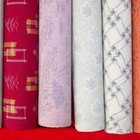
belchonock/iStock/Getty Images
Polyester and cotton are crucial materials in the fabric and garment-making industries because each has a number of useful characteristics. Poly-cotton blends are created by employing industrial weavers and looms to combine the two fibers; blend ratios typically range from 65 percent cotton and 35 percent polyester to a 50-50 mix. While these blends may have some cons, the far more plentiful pros mean that poly-cottons are ideal for artistically-minded craftspeople who enjoy making their own clothing, costumes and furniture coverings.
The Pros
Poly-cotton blends are strong, durable and tear-resistant, thanks to the fact that polyester fibers are far more elastic than cotton alone. Also, polyester doesn't shrink and change shape the way cotton does, giving users of the blend more latitude in how the fabric is washed and dried. However, thanks to the cotton component, blends are very abrasion-resistant and far more breathable than pure polyester. In addition, poly-cotton blends can be dyed in a wide range of colors and, because they are so widely available, tend to be far cheaper than pure cotton fabrics.
The Cons
In the world of high fashion, polyester and synthetic blends acquired a reputation for looking cheap, tacky and unnatural, unlike pure cotton. They are less breathable than cotton due to the polyester component, which means they trap moisture and stick to the skin more readily when a person perspires. They are less fire-resistant than cotton by itself and tend to melt when ignited. The polyester makes blends less absorbent than pure cotton, while the cotton makes them more susceptible to staining. Poly-cotton blends are also pricier than pure polyester because of the cotton's higher pricing.
Common Uses
Poly-cotton blends are most used in the consumer clothing industry and are found in abundance at retail outlets. Lightweight blends are used for shirts and blouses, while heavier ones are reserved for skirts and pants, all in a variety of ratios. Commercial clothing such as corporate uniforms and athletic team uniforms also use blends: a 50-50 ratio is most popular because of its balance between breathability and durability. Other common uses include pillows, bed sheets, tablecloths and exhibition canvas.
Care Information
The easy nature of polyester overwhelms the difficulties of cotton, making poly-cotton blends simple to care for. The ratio of cotton to polyester ultimately decides how forgiving the fabric is, however. The higher the cotton concentration, the more challenging care becomes. With blends that contain at least 50 percent polyester, a warm wash and gentle ironing is recommended for best results, although high-temperature laundering is permissible if necessary.
Related Articles

Characteristics of Polyester & Cotton

What Is Pinpoint Cotton?

What Is Artificial Silk?

Microfiber vs. Cotton Clothes

Description and Characteristics of ...

The Difference in Lycra & Cotton

The Advantages & Disadvantages of Woven ...

Denim vs. Denim Blends

Advantages & Disadvantages of Natural ...

How Much of the World's Clothing Is ...

The Advantages of Polyester Cotton

Uses of Cotton Fabric

Twill vs a Cotton-Polyester Blend

Cordura Vs. Leather

What Is the Difference Between Acrylic ...

How to Care for Rayon and Spandex ...

Properties of Cotton Fabric

Types of Linen Fabric

Microfiber vs. Cotton Clothes

What Is the Difference Between Lycra ...
References
Writer Bio
Mark Heidelberger has been writing for more than 22 years, from articles and short stories to novels and screenplays. He is a consummate foodie, loves to travel and has run several businesses, all of which influence his work. He also holds a Master of Fine Arts degree from UCLA.
Photo Credits
belchonock/iStock/Getty Images